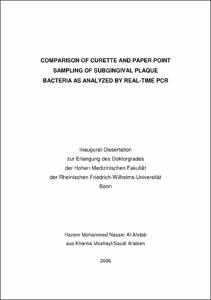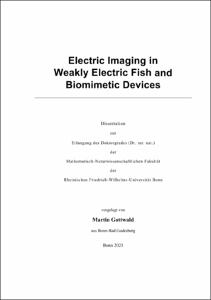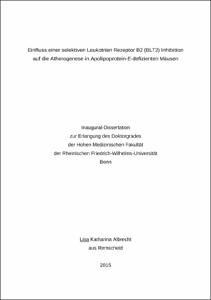Al Ahdab, Hazem Mohammed Nasser: Comparison of curette and paper point sampling of subgingival plaque bacteria as analyzed by real-time PCR. - Bonn, 2006. - Dissertation, Rheinische Friedrich-Wilhelms-Universität Bonn.
Online-Ausgabe in bonndoc: https://nbn-resolving.org/urn:nbn:de:hbz:5M-07721
Online-Ausgabe in bonndoc: https://nbn-resolving.org/urn:nbn:de:hbz:5M-07721
@phdthesis{handle:20.500.11811/2421,
urn: https://nbn-resolving.org/urn:nbn:de:hbz:5M-07721,
author = {{Hazem Mohammed Nasser Al Ahdab}},
title = {Comparison of curette and paper point sampling of subgingival plaque bacteria as analyzed by real-time PCR},
school = {Rheinische Friedrich-Wilhelms-Universität Bonn},
year = 2006,
note = {Because of their important etiological role in periodontitis the microbiological identification of subgingival plaque bacteria is essential for clinical diagnostics. However, only few studies have systematically evaluated microbiological sampling methods of periodontal bacteria. The present study has been conducted to compare for the first time two widely used sampling techniques (paper point and curette) using the novel method of quantitative real-time PCR.
Twenty adult patients with chronic periodontitis participated in a prospective study using a cross-over design. In each patient one periodontal pocket with a probing depth of more than 6 mm was selected for microbial sampling. In patients of group A the first sample was obtained with a paper point and the second with a Gracey-curette. In group B the sampling sequence was reversed. Samples were analysed by a blinded examiner in a specialised microbiological laboratory using real-time PCR technology. The analysis enabled the quantitative evaluation of Actinobacillus actinomycetemcomitans, Fusobacterium nucleatum ssp., Porphyromonas gingivalis, Prevotella intermedia, Treponema denticola, Tannerella forsythia as well as total bacterial counts. Eight weeks after anti-infective periodontal therapy the sites were sampled again, using the same sampling sequence as before. Statistical analysis included t-test, Kappa and Spearman correlation.
In this study higher total bacterial counts could be harvested by use of curettes than by paper points. The ratios between paper point and curette samples in group A were 1:4 before and 1:1 after therapy, in group B the respective values were 1:4 before and 1:3 after therapy. In contrast, the relative proportions of target bacteria in the total sample were similar. Following therapy, both sampling techniques showed a reduction of total bacterial counts as well as of the relative proportion of periodontopathogens.
Overall, there was a relatively good agreement for the results of the investigated sampling techniques for the analysis of subgingival plaque bacteria. Thus, both techniques appear to well suited for microbiological diagnostics of patients with periodontitis.},
url = {https://hdl.handle.net/20.500.11811/2421}
}
urn: https://nbn-resolving.org/urn:nbn:de:hbz:5M-07721,
author = {{Hazem Mohammed Nasser Al Ahdab}},
title = {Comparison of curette and paper point sampling of subgingival plaque bacteria as analyzed by real-time PCR},
school = {Rheinische Friedrich-Wilhelms-Universität Bonn},
year = 2006,
note = {Because of their important etiological role in periodontitis the microbiological identification of subgingival plaque bacteria is essential for clinical diagnostics. However, only few studies have systematically evaluated microbiological sampling methods of periodontal bacteria. The present study has been conducted to compare for the first time two widely used sampling techniques (paper point and curette) using the novel method of quantitative real-time PCR.
Twenty adult patients with chronic periodontitis participated in a prospective study using a cross-over design. In each patient one periodontal pocket with a probing depth of more than 6 mm was selected for microbial sampling. In patients of group A the first sample was obtained with a paper point and the second with a Gracey-curette. In group B the sampling sequence was reversed. Samples were analysed by a blinded examiner in a specialised microbiological laboratory using real-time PCR technology. The analysis enabled the quantitative evaluation of Actinobacillus actinomycetemcomitans, Fusobacterium nucleatum ssp., Porphyromonas gingivalis, Prevotella intermedia, Treponema denticola, Tannerella forsythia as well as total bacterial counts. Eight weeks after anti-infective periodontal therapy the sites were sampled again, using the same sampling sequence as before. Statistical analysis included t-test, Kappa and Spearman correlation.
In this study higher total bacterial counts could be harvested by use of curettes than by paper points. The ratios between paper point and curette samples in group A were 1:4 before and 1:1 after therapy, in group B the respective values were 1:4 before and 1:3 after therapy. In contrast, the relative proportions of target bacteria in the total sample were similar. Following therapy, both sampling techniques showed a reduction of total bacterial counts as well as of the relative proportion of periodontopathogens.
Overall, there was a relatively good agreement for the results of the investigated sampling techniques for the analysis of subgingival plaque bacteria. Thus, both techniques appear to well suited for microbiological diagnostics of patients with periodontitis.},
url = {https://hdl.handle.net/20.500.11811/2421}
}









